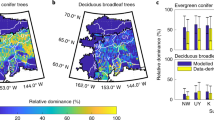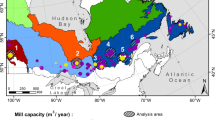Abstract
Predicted future changes in regional climate under a doubling of atmospheric CO2 concentrations were applied to the 1951–80 normals of 254 climate stations to examine future impacts on the boreal forest of western Canada. Previous analyses have indicated that in this region, the southern boreal forest is presently restricted to areas where annual precipitation (P) exceeds potential evapotranspiration (PET). The present analysis suggests that a predicted 11% increase in P would be insufficient to offset the increases in PET resulting from a predicted warming of 4–5°C. As a result, half of the western Canadian boreal forest could be exposed to a drier climate similar to the present aspen parkland zone (P < PET), where conifers are generally absent and aspen is restricted to patches of stunted trees interspersed with grassland. Future changes could result in permanent losses of forest cover following disturbance and an increase in the proportion of exposed edge habitat in remaining stands, where environmental conditions might induce additional stresses on tree growth. Thus if the predicted warming and drying occurs, productivity of aspen and other commercial species in the southern boreal forest would be greatly reduced.
Similar content being viewed by others
References
Boer, G. J., McFarlane, N. A. and Lazare, M.: 1992,J. Climate 5, 1045–1077.
Bonan, G. B.: 1989,Ecol. Model. 45, 275–306.
Campbell, C., Campbell, I. D. and Hogg, E. H.: 1994,Geogr. Phys. Quatern. 48, 207–212.
Ecoregions Working Group: 1989,Ecol. Land Classifi. Series No. 23, Sustainable Development Branch, Canadian Wildlife Service, Conservation and Protection, Environment Canada, Ottawa, Canada, 119 pp.
Fisheries and Environment Canada: 1978,Hydrological Atlas of Canada, Surveys and Mapping Branch, Department Energy, Mines and Resources, Ottawa, Canada, 34 maps.
Flannigan, M. D. and Van Wagner, C. E.: 1991,Can. J. For. Res. 21, 66–72.
Gullett, D. W. and Skinner, W. R.: 1992,The State of Canada's Climate: Temperature Change in Canada 1895–1991, Environment Canada SOE Report No. 92-2, Dept. Supply and Services, Ottawa, Canada, 36 pp.
Hirsch, K. G.: 1991,For. Chron. 67, 358–365.
Hogg, E. H.: 1994,Can. J. For. Res. 24, 1835–1845.
Houghton, J. T., Jenkins, G. and Ephraums, J. J. (eds.), 1990,Climate Change, The IPCC Scientific Assessment, Cambridge University Press, Cambridge, UK, 365 pp.
Huang, S. and Titus, S.J.: 1992,Can. J. For. Res. 22, 1297–1304.
Ives, W. G. H.: 1981,Environmental Factors Affecting 21 Forest Insect Defoliators in Manitoba and Saskatchewan, 1945–69. Can. For. Serv. Inf. Rep. NOR-X-233, Canadian Forestry Service, Edmonton, Canada, 142 pp.
Jensen, M. E., Burman, R. D. and Allen, R. G. (eds.): 1990,Evapotranspiration and Irrigation Water Requirements, American Society of Civil Engineers, Man. Rep. Eng. Pract.70, Am. Soc. Civ. Eng., New York, USA 332 pp.
Johnstone, W. D. and Peterson, E. B.: 1980,Above-Ground Component Weights in Alberta Populus Stands. Can. For. Serv. Inf. Rep. NOR-X-226, Canadian Forestry Service, Edmonton, Canada, 18 pp.
Kerr, J. B. and McElroy, C. T.: 1993,Science 262, 1032–1033.
Kirby, C. L., Bailey, W. S. and Gilmour, J. G.: 1957,The Growth and Yield of Aspen in Saskatchewan, Tech. Bull.3, Sask. Dep. Nat. Resour., For. Branch, Prince Albert, Canada, 67 pp.
Long, S. P. and Hutchin, P. R.: 1981,Ecol. Appl. 1, 139–156.
Looman, J.: 1979,Phytocoenologia 5, 347–366.
MacDonald, G. M. and Ritchie, J. C.: 1986,New Phytol 103, 245–268.
Maini, J. S.: 1968,In: Maini, J. S. and Cayford, J. H. (eds.),Growth and Utilization of Poplars in Canada, Publ. 1205, Dep. For. Rural Dev., Ottawa, Canada, pp. 20–69.
Manabe, S., Spelman, M. J. and Stouffer, R. J.: 1992,J. Climate 5, 105–126.
Peterson, E. B. and Peterson, N. M.: 1992,Ecology, Management, and Use of Aspen and Balsam Poplar in the Prairie Provinces, Canada, Forestry Canada, Northwest Region, Special Report1, Edmonton, Canada, 252 pp.
Price, D. T. and Apps, M. J.: 1995,Water, Air, Soil Pollut. 82, 203–214.
Rowe, J. S. and Coupland, R. T.: 1984,Prairie Forum 9, 231–248.
Schwarz, A. G. and Wein, R. W.: 1990,In: Smith, D. D. and Jacobs, C. A. (eds.), Proc. 12th North Am. Prairie Conf., 5–9 August 1990, University of Northern Iowa, Cedar Falls, USA, pp. 1–4.
Smith, T. M., Leemans, R. and Shugart, H. H.: 1992,Clim. Change 21, 367–384.
Vitt, D. H., Halsey, L. A. and Zoltai, S. C.: 1994,Arctic and Alpine Res. 26, 1–13.
Yakimchuk, R. and Hoddinott, J.: 1994,Can. J. For. Res. 24, 1–8.
Zoltai, S. C.: 1975,Southern Limit of Coniferous Trees on the Canadian Prairies, Can. For, Serv. Inf. Rep. NOR-X-128, Canadian Forestry Service, Edmonton, Canada, 12 pp. + maps.
Zoltai, S. C., Singh T. and Apps, M. J.: 1991,In: Navratil, S. and Chapman, P. B. (eds.),Aspen Management for the 21st Century, Forestry Canada, Northwest Region, Edmonton, Canada, pp. 143–152.
Author information
Authors and Affiliations
Rights and permissions
About this article
Cite this article
Hogg, E.H., Hurdle, P.A. The aspen parkland in western Canada: A dry-climate analogue for the future boreal forest?. Water Air Soil Pollut 82, 391–400 (1995). https://doi.org/10.1007/BF01182849
Issue Date:
DOI: https://doi.org/10.1007/BF01182849




